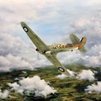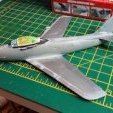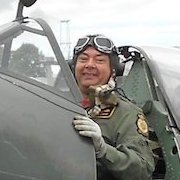Search the Community
Showing results for tags 'Trumpeter'.
-
Apologies in advance for another 1/200 build, but this is the largest & most expensive build I've ever attempted, so it warrants documentation. I've been wanting this kit ever since it was announced, and the addition of a full aftermarket kit that could be purchased with all added extras as one unit was ultimately very appealing. Over the last couple of years, I've built three ancient 1/600 Airfix kits for a friend of mine, who decided to buy this kit for me as a thank you. Suffice to say I was over the moon! At this point in time, I'm still working on acquiring the right paints for this kit in its 1944 pre refit camouflage scheme. But with the amount of PE involved, it could be a while before the airbrush comes out at any rate. So without further ado, let's do this... While waiting for the Pontos set to arrive, I did what I could in the meantime which included adding the bulkheads and sanding smooth the plugs on the bottom of the hull. I downloaded a set of Pontos instructions and set about removing the plastic parts as per the instructions. It was way easier than expected. That's all for now, More updates soon! Thanks for looking!
-
Hallo again Well, this is my first MIG-21 F-13 in a bigger serie of 21s. With Eduard etched parts, Master probe, Russian decals etc. Well, so I will start my next one. PF from Eduard. Happy modelling
-
Hi All, Finally building a model I bought during the lockdown but not for a groupbuild! This is Trumpeter's 1/32 P-38L-5-LO, the definitive version of the Lightning which really perfected an already excellent design. Although not as well-known as other American WW2 fighters like the P-51 and P-47, the fact that this fighter was already in service before the US even entered the war is quite extraordinary. The kit is quite well-known and definitely one of the best kits Trumpy have produced. (You can read all about it HERE to save having to repost all the sprue pics). Worth saying it's a big and beautifully produced kit, though afflicted with the usual Trumpeter ingredients (sprues of completely superfluous and mostly invisible detail and weird, fiddly multimedia flaps and control surfaces which will not be required!) The build begins with the engines, strangely enough: These fantastically moulded, intricate pieces are duplicated for both sides, and include the complete mounting and supercharger connection pipes. Unfortunately the kit doesn't offer any removable panels or open cowls to make them viewable So I'm assembling them for fun but they'll be invisible when fitted. Slightly bizarre, but there you go. I'm cracking through this to give the impression of progress while I'm slogging through building my 1/32 resin Buccaneer. Hope to provide regular updates as I'm due to return to work fairly soon and don't know how much of this lovely modelling time I have left! Cheers, Alan
-
Hi all, Finished this very morning is the Trumpeter 1/32 P-38L Lightning, a truly beautiful aeroplane that has passed me by for years but I finally discovered it Build thread is here: Happy to answer any questions and feel free to comment, good bad or indifferent Cheers everyone and look after yourselves, Alan
-
Hey there, I found that I have too many Panther tanks and fancied something else for quite some time and not got to support local hoppy shops. Finally went for KV-1 kits. I ordered the Tamiya kit with the ABER detail bits to get a bit more finesse into this one. The detail ootb ist good but as with many of the RC tanks not overwhelmingly. This most likely has to do with tha fact that you will handle it alot and that might damage too finely detailed models. Still I got the Trumpeter to look for some additional details to add to its´ larger brother. I plan to do texture most of the surfaces with Mr Surfacer 500 for the rough look. Tamiya just has it how to do an appealing box. Fold up the box lid and you get to see a very nice picture together with a windowed box on all the goodies inside. I remember when I was a child and I did that for the first time in the shops, but I never had the money to afford one of these models.
-
I seem to recall a Trumpeter 1/350 HMS Exeter build some time back which highlighted some issues with the moulded on wooden deck pattern, and parts which were not planked at all? I think it was @Jamie @ Sovereign Hobbies build. Does anyone know if the Trumpeter 1/350 HMS York rendering has the same issues? Thanks Terry
-
Hi all. Just finished this one. Nice kit on the external but i got very disappointed with the cockpit. The seat provided is very undesized and the floor is very shallow. Had to use a spare seat and make adjustments to lower the cockpit floor to hold the new seat. but considering the canopy is very small theres nothing to see through it anyway, so i did no other changes on the interior. The nose gear is also very fragile. The kit fits very well and needs almost none putty to same small gaps. Decals sheet is very limited also. To complete this build i decided to go with the Olive Drab paint option but after finished it went to dark. a lighter painting whould fit much better. I am on hold for years for the Announced MIG-19P by trumpeter, but if it ever be released based on something like this one it wont be a hit. To compare my old KP MIG-19 wich i used cockpit and canopy aftermarkets, downed the panel lines and done some scratch adjustments on the gears, nozzles and tail elevator. Thank you all. Luciano
-
Another Su I just made, this time was in Navy camouflage scheme. And again, lots of time in the exhaust. Each Su i tried different technique to achieve the burning metal result. Enjoy guys.
- 21 replies
-
- 40
-

-
Hi all, now that the July issue of Airfix Model World issue has finished selling, I can finally show this... Last year whilst on holiday in Australia, I finally managed to get a jet in my flying log book. It's an L-39C Albatros belonging to a company at Archerfield Airport in Brisbane, and I managed to hire it for a while along with a pilot to keep an eye on it while I played with it. Returning home, I built a copy of it as a keepsake, using the Trumpeter 1/48 kit as a base, but incorporating scratch built parts, self made decals, and masks for some of the markings cut by my mate Nige. Hope you like it. Photos from the day: It's all good fun. Cheers, Dean
-
Hello friends, new project on the bench...
-
Hallo This kit I built straight from the box. Nice kit, and quite straight to build. What I do wonder most of all: The parts are so small and so fine mold, that the quality gap of kit parts between aircraft and vehicle is so big. Why is it? Since with this quality standard of vehicle plastic parts we could omit most resin in aircraft kits? Even the best aircraft kits do not reach this level!!!???? Happy modelling
-
HMS Roberts Trumpeter 1/350 History HMS Roberts was the first of a two ship class of 15” Monitors. Her keel was laid on April 30th 1940 at John Browns shipyard on the Clyde, and was launched on the 1st of February 1941. HMS Roberts was commissioned, six months late, (due mainly to have repairs made good on damage caused during an air raid), on 6th October 1941, she left Clydebank three days later for the Gareloch where she was dry docked in a floating dock brought up specifically for the job, as no other dock was able to accommodate the Roberts extreme beam. Once trials and final adjustments had been completed, it wasn’t until 13th November that she sailed for work up and to prepare for the long voyage out to the Mediterranean via the Cape of Good Hope. She did not arrive at Suez until the 26th February 1942. She remained at Suez, acting as AA guardship, and was anchored about three miles south of the canal entrance. Her radars and AA directors, added to her design during construction, proving particularly useful, although no action was actually seen during this time. In July 1942 she moved down the Red Sea for a few weeks , before she was ordered to sail for an unspecified operation. This operation turned out to be Operation Torch, the landings in North Africa. Throughout the landings she was anchored seven miles off the coast, but didn’t fire a shot as the French fort Sidi Ferruch did not resist the allied troops. The day after the landings she acted as radar guardship, warning of the approach of any German aircraft from the direction of Tunisia. Her AA guns were used against sustained air attacks, particularly from Ju-88s. She continued in this role until the 11th, when she was hit by two 500kg bombs, one hitting the port side sloping armour on the bulge and the other just aft of the funnel. She was immobilised for two days, before repairs were completed to allow her to sail, all the time still under constant air attack. During the operation she had fired off some 30,000 rounds of AA ammunition in less than a week. With the worst of the bomb damage repaired she went back to her duties and AA guardship until finally relieved, sailing for Gibraltar and home, arriving in Liverpool on the 6th January. The rest of 1943 saw the Roberts providing both AA and 15” cover for operations around the Mediterranean including the landings at Salerno, where she bombarded enemy positions from the 9th to the 19th of September on which she sailed back to Malta to replenish her ammunition as she had fired almost her entire complement of 15” shells during the actions off the beaches. April 1944 HMS Roberts found herself back in home waters to work up for Operation Neptune and to carry out practice bombardments on the Kintyre range in company with the other ships of the bombardment fleet. Owing to her slow speed, she had to sail several days in advance of the rest of Force D, arriving at Spithead on the 28th May to await orders for the invasion fleet to sail to France. On the 5th June she sailed as part of convoy S.6, joining up with the other bombardment ships and minesweepers coming from the Clyde. The Roberts anchored in her firing position eleven miles west of LeHavre at 05.20 on the 6th of June 1944, three minutes later she opened fire from about 20,000 yards range on the Houlgate battery, which had four ex-French 155mm guns, ten miles east of Sword beach. A heavy fire was kept up on the enemy batteries until H hour. Roberts fired some twenty seven rounds during this period, but had difficulty in spotting the fall of shot due to enemy smokescreens and the failure of some armoured piercing rounds to explode in the marshy ground. Periodic fire was required throughout the day to silence any batteries that showed signs of interfering with the build up of troops, vehicles and stores on the beachhead. Most batteries though concentrated their fire on the bombardment ships rather than the flimsy landing craft. During the afternoon of D-Day Roberts made a particularly successful shoot on Houlgate, after sixteen rounds, the spotting fighter reported several direct hits and two large explosions. At 21.30 she had just started to fire on a troop concentration inland from Sword beach, when a crash was heard and a large chunk of metal was seen to fly up in front of the bridge. On ceasing fire it was found that the right 15in had burst its jacket. The jacket had split into several pieces without the whole gun bursting, so further damage was prevented by strapping it with wire rope. It wasn’t until after further action off the Seine and on targets around Caen, using only the one good barrel that she finally was sent back to Portsmouth on the 14th June with only 37 of her compliment of 235 15in rounds left and to replace her guns as the remaining barrel was also out of life. One of the replacement guns was No102, which is now to be found outside the Imperial War Museum, London. By the 21st of June Roberts was back on station on the Eastern flank of the beachhead. Up until the final day of the bombardment operation on the 18th July she continued to give covering fire throughout her operational area. To increase the range out to 30,000 yards the monitor was flooded on one side to give a three degree list to give the guns greater elevation. Roberts returned to Portsmouth on the 23rd July for the next ten weeks, to change her guns, again, give leave and repair the wear and tear of six weeks almost continuous bombardment in which she had fired 692 rounds of 15in, of which only about sixty being armoured piercing. Having completed her duties off the French coast, Roberts took part in the commando landings at Flushing and bombarded the gun emplacements around Zeebrugge. This turned out to be the last action HMS Roberts would take part in, as although she was primed at four hours notice to bombard forts on Heligoland, the operations were called off as the German defence of the Reich collapsed, and the ship’s crew celebrated VE day in Portsmouth. Allocated to the Far East Fleet, she sailed to the Mersey for a quick refit before setting sail on the 27th July 1945 bound for the Indian Ocean where she was ordered arrive before the 1st September to acclimatise before operations against Singapore. Fortunately, the dropping of the two atomic bombs precluded they use, yet she and her sister Abercrombie continued to sail Eastwards until the formal Japanese surrender. The order for the two ships to return and reduce to reserve came on the 11th September, by which time the Roberts had reached Kilindini. The Roberts finally arrived at Plymouth on the 22nd November. Whilst her sister didn’t survive long after the war, being reduced to an accommodation ship and turret drill ship in 1946 before being laid up in Fareham Creek in 1953 and scrapped in 1954/55, HMS Roberts survived quite a bit longer. After arriving in Devonport, she stayed there until 1965, being used as a turret drill ship, accommodation ship and even the headquarters of a sailing club. On the 3rd of August 1965 she arrived at the Wards berth in Inverkeithing to be scrapped. This was the end of the Big Gun Monitors in the Royal Navy after nearly 50 years of service. The Model It was a very pleasant surprise to hear of Trumpeter releasing this 1:350 kit as it would be the first time it has been done in this scale as an injection moulding. The only other option has been the fantastic, but rather expensive resin offering from White Ensign Models. Due to one thing and another we didn’t receive the kit for review until very recently, so I was eager to get the box open and see what it was like. The box lid has a nice painting of the Roberts on the gun line of one of its operations. On opening the box the modeller is confronted with seven sprues of light grey styrene, with separate hull halves and main deck. There are also three frets of etched brass, a small stand and an even smaller decal sheet. The mouldings are really nicely done with some fine detail evident throughout the sprues. There are no signs of defects and not that many moulding pips, being only seen on some of the smaller parts. Unfortunately there is quite a big fly in the ointment as, once again, Trumpeter seem to have mucked up the hull, particularly the foreward end of the bulge, which runs to far foreward on each side, to almost underneath the anchors. The whole hull doesn’t appear deep enough either, although the general shape isn’t too bad. The foreward bulge really needs to sanded away, but due to the way it’s indented this would leave a whole that will require sheeting over with plasticard and filler, probably something only the most fastidious modeller would try. Moving on to the build, construction starts with the two hull halves being joined together. Now, there are several large spurs on both hull joints and gunwhales where they have been cut away from the sprues, which have to be carefully removed before joining. Even though the hull is pretty stiff already due to the shape, Trumpeter have provided three bulkheads and two joining pins to give extra strength and also for giving the main deck somewhere to be affixed to. That said, the next step is to fix the main deck to the hull, before being turned over to have the bilge keels attached, followed by the two propeller shafts, a frames, propellers and rudders fitted into their respective positions. With the hull complete, it’s on with a raft of sub-assemblies, including windlasses, air vents, lookout binoculars, and two Type 282 directors. The weapons assemblies are then built up, the octuple and quad pom pom mounts, (the instructions appear to be wrong, in that it tells you to build two octuple mounts and one quad, whereas it should be the other way round), single 40mm mounts, (which weren’t fitted to the Roberts until 1945), include both styrene and etched parts, whereas the four twin 4” turrets and twin 20mm mounts, (only fitted to the Roberts in 1945), are purely styrene in construction. The next batch of sub-assemblies include the Type 284 directors, fitted with etched Yagi aerials, and three different styles of liferafts, stacked in twos and fours. The main 15” turret is made up of the main turret, turret base and a choice of either moveable barrels, without blast bags, or fixed, with blast bags. Putting the sub-assemblies aside, and with the hull the right way up, the breakwater and storage locker are fitted to the foredeck, along with two 40mm gun tubs. Either side of the main barbette the two quad pom pom splinter shields are fitted, whilst further back on each side the splinter shields for the 4” turrets are attached. The many and various ready use lockers, complete with etched doors are fitted in their appropriate positions, followed by the liferaft stacks. The four paravanes, windlasses, fore and aft anchors, plus their anchor chains and more ready use lockers are fitted. The build then moves onto the aft superstructure with the structures of 01 deck being glued onto the bottom structure. The etched vertical ladders are fitted, along with yet more ready use lockers, followed by the Type 284 mounts, octuple pom pom, three 40mm mounts, the emergency steering position and the twin 20mm mounts. The railings around the 02 deck structures are also attached, thoughtfully provided in the kit. Moving foreward the single piece bridge structure, (like a smaller Queen Annes Mansions seen on the likes of HMS Warspite), which is fitted out with the rear upper bridge surround, rear bridge detail plate, ready use lockers, vertical and inclined ladders, chart and wireless offices, lookout binoculars, aldis lamps, main rangefinder and bridge screen. The structure between the bridge and turret barbette is fitted out with two twin 20mm mounts, their ready use lockers and another stack of liferafts. The funnel is moulded in two halves, which, once joined together is topped out with a two piece etched funnel cap and fitted out with a number of steam pipes on the forward face. These assemblies are then attached to the main deck and at last it’s beginning to look like a warship. Before the assembly of the two masts the midships 40mm mounts are fitted in their elevated tubs, whilst either side of the turret barbette, in similar elevated mounts the two Type 282 directors are fitted. More railings around the upper decks can be fitted now, or the modeller may wish to wait till the end of the main build. The mainmast is assembled from a single pole foreward and double pole moulding aft, connected by two Y shaped struts. To the front pole a long vertical etched ladder is affixed. The top of the mast is fitted out with an oblong star platform on which the mast for the aft Type 281aerial is attached, followed by the yardarm, vertical ladder and etched radar aerial which will need some careful folding to keep everything square. The supporting rear poles of the tripod for the foremast are slid into position to the rear of the bridge structure. The fore pole fitted on top of the bridge, with the large starfish platform, (made entirely of etched parts), fixed to the top of the three poles. The spotting top is fitted onto the starfish platform along with the mast and Type 281 aerial as per the mainmast assembly. With the masts fitted into place, the 4”, 15” turrets can be fitted, as are the forward quad pom pom mounts and foredeck mounted 40mm units. Sundry items, such as the foredeck derricks, Jack Staff and Ensign Staff, ships boats, boat booms, accommodation ladders and quarterdeck derricks are attached. Finally the boat davits, acoustic hammer, (actually removed in 1945), hammer derrick and ships railings are fitted, thus completing the build. Decals The small decal sheet provides just two types of White Ensign, one wavy and one straight. Conclusion I really am quite disappointed with this kit. It had so much promise on opening the box, but Trumpeter has once again snatched defeat from the jaws of victory. The hull, especially the extended bulge seems to have been made by the same team that made, and mucked up the same area, that designed their HMS Warspite. That flaw and the fact that the hull appears to be too shallow overall, but mostly under the waterline makes the whole ship look wrong in its proportions. The twin 20mm mounts and single 40mm Bofors, according to my references, were only fitted to the Roberts in 1945, yet the acoustic hammer was removed, (although the derrick was retained), in the refit before sailing to the Far East. If you want to build HMS Roberts as per her time at Salerno or on D-Day, at the very least you will also need to find some single 20mm mounts to replace the 40mm, another Type 282 director and pair of searchlights, which is a shame really, as the boxart shows her during her bombardment of France during D-Day. Recommended with the above caveats. Review sample courtesy of UK Distributors for
- 14 replies
-
- 5
-

-
- 1:350
- HMS Roberts
-
(and 1 more)
Tagged with:
-
RA-5C Vigilante BuNo156633/NK603 of RVAH-13, USS Enterprise, Operation Linebacker II, December 1972 The last of the Vigilantes to be lost in the Vietnam war. It was hit by 'Atoll' missile fired by MiG-21 - unfortunately killing the navigator and pilot becoming a POW. This was in fact the only Vigilante lost in aerial combat. Kit: Trumpeter RA-5C Vigilante (#01616) Scale: 1/72 Aftermarket: Eduard Photo Etch, Master pitot tube, Print Scale decals Paints: Vallejo Model Color, Model Air & Metal Color Weathering: Flory Models Wash, Mig weathering products Mixed feelings about this kit - but it's (more or less) a Vigilante, so that's cool Built for the In The Navy GB. Build thread:
- 28 replies
-
- 55
-

-
Hi, I bought this model as an impulse buy in the hannants tent about 2 years ago at one of the Duxford air shows. At the time I had lots of models to build so I wasn't looking too hard at the kits but temptation seemed to find me anyway. When I got home I realised (yet again) that Trumpeter had very cleverly boxed the item to look extremly appealing, but of course as soon as I began to do some research I realised that work needed to be done to bring it up to scratch. Other than the usual inconveniently placed ejector moulding pin circles that you come to expect from most trumpeter kits, there was also the considerable problem of size. Many of the moulded on details are just plain chunky. Fortunately for me (but not my wallet) Eduard came to my rescue in their Big Ed set. Now I had 8 sheets of photoetch to improve my model with. But still that wasn't enough, so back to the internet where I found Libor's fabulous build log of the very same model which ultimately led to me purchasing all of his 5 resin sets from LZ models for the loco (cue more misfortune for the wallet). Now this man is somewhat of a detail specialist and his resin sets are quite something. The only flaw being that the instructions on where to put all the parts still confuses me but I suppose that as these are his very first commercial resin sets that he produced so I can't expect them to be perfect. Below is a good example though of the improvement i'm going to get from using the resin instead of the kit parts, (this is a part of one of the domes on top of the boiler). And here's all the resin sets I also intend to build a diorama base for it so I also bought a water pump and some scenic materials. All of this adds up to a LOT of stuff! The kit All the extras together Anyway enough about all that and back to the actual build. I've done a few of my own modifications to the kit (mainly removing things and making holes!) After all that I eneded up taking a long break from this model. It stalled because I wanted to buy some metal rails and attach them to the diorama base so I could make sure that all my wheels were going to sit on the rails (I notice the little wheels at the front and back hanging in mid air in quite a few built versions!). I'd decided that it would be best to do any required adjustments before i got down to painting. Unfortunately of the 2 companies online that do what I want the one that I chose didn't seem all that keen on sending me only 2 pieces of track. I asked them for a price, they gave me one then I asked them about payment methods (it wasn't at all clear on their site) then I never did get a reply. I was going to phone but I just never did, the model got packed into a box after a few months and there it lay for about a year and half. The model came back out of the box a couple of weeks ago and I became determined that this time it will get done! Ironically I still haven't got those rails, it's been about 2 weeks after David phoned in my order and gave his payment details and I haven't got an order and I haven't been charged for one! It's time to phone them up again.... Rail troubles aside I began by building the bunker at the back (at least I think that's it, railway terminology is not my strong point) and adding the photo etch. I also did a bit of work removing and thinning some over exaggerated detail. At the moment i'm beginning to work on the cab, I got my photoetch glued to my roof yesterday and i've begun to contemplate the boiler. At the moment it's pretty simple and in some places inaccurate, the photo etch and resin will add a considerable amount of detail but I still need to work on some elements and work out which of the extra parts go where, what I need to scratch build and what order I need to do things in. In short a lot of thinking! Anyway I hope you enjoyed my introduction to my latest creation and that it isn't too long! Amanda
-
I fancied a quick aircraft build without too much effort, so found this rather nasty harrier in the stash, there's so much wrong with this kit - shape of the nose, wings, pylons, errors in the gun pods, general lack of detail etc that is also hard to correct, so I was never going to build it properly. Instead I just lashed it together as a quick, fun build to get me back into aircraft, which it mostly was in fairness, apart from the canopy which has a big prominent seam down the centre and didn't fit especially well. I think It looks mostly OK and a bit like a harrier (from a distance!) so there you go Thanks for looking Nick
- 16 replies
-
- 33
-

-
Hello all, I hope everyone is keeping safe in these crazy times. While I have been off due to this enforced lockdown I started the Trumpeter ME262 A-1a heavy armament kit and wanted to do it in the colours of yellow 3 from KG(J)54. The kit decals seemed a big 'off' so I invested in Eagalcals #95-32 sheet and the colours seemed much better than the kit originals. I have been my best to get the scheme right, but even I will admit that its not quite right, but I think it looks pretty good, certainly a good learning session for sure. Painted with Gunze Sanyo (best paints EVER in my opinion) and weathered with oils. I'd like to add that the markings aren't symmetrical as that's the way they are on the original aircraft (very odd that). All comments welcome
-
Here it is all done, there is a WIP if you haven't seen it already. This was a Christmas present from the girls along with the update kit. This was supposed to be a summer project following my holiday of a lifetime after retirement, but hey ho. I started building on the 1st Feb and finally called it finished last week. LAV 1 by phil da greek, on Flickr LAV 14 by phil da greek, on Flickr LAV 37 by phil da greek, on Flickr So here we go, this doesn't represent one particular vehicle but rather is an amalgamation of several hundreds of LAV photos I've discovered on the internet, but the pose of the figure does come from one particuar photo of the Canadians in Afghanistan. I'm pretty happy with it overall, but the figure disappoints me as I found the CADPAT particularly challenging, the sharp digital pattern has turned into a series of dots and blobs. LAV 78 by phil da greek, on Flickr LAV 79 by phil da greek, on Flickr LAV 80 by phil da greek, on Flickr LAV 81 by phil da greek, on Flickr LAV 82 by phil da greek, on Flickr LAV 83 by phil da greek, on Flickr LAV 84 by phil da greek, on Flickr LAV 85 by phil da greek, on Flickr LAV 86 by phil da greek, on Flickr LAV 87 by phil da greek, on Flickr LAV 88 by phil da greek, on Flickr LAV 89 by phil da greek, on Flickr LAV 90 by phil da greek, on Flickr LAV 91 by phil da greek, on Flickr LAV 92 by phil da greek, on Flickr LAV 93 by phil da greek, on Flickr LAV 94 by phil da greek, on Flickr LAV 95 by phil da greek, on Flickr LAV 96 by phil da greek, on Flickr LAV 97 by phil da greek, on Flickr LAV 99 by phil da greek, on Flickr LAV 100 by phil da greek, on Flickr LAV 101 by phil da greek, on Flickr There we go, an enjoyable build of a good kit. Thanks for looking in!
- 13 replies
-
- 22
-

-
Hi all, Going to finally getting around to doing my Trumpeter 1/48 Spiteful. Made a half hearted attempt to start it a few years back, glued the undercarriage doors up into the lower wing as I as planning on doing it in flight. Hard to believe but Trumpeter got their research wrong with the box art, RB518 depicted was a F.16, so I'll be modifying the serial to reflect RB515 which was the first production F.14
-
Just finished - the excellent Trumpeter Su-34 kit in 1/72 scale........ Trumpeter missed a few things - the curved fillet between the wing L/E and the ESM pod (when fitted)..... ... the Blind Flying curtains inside the cockpit..... .... and the APU exhaust outlet on top of the tailboom... Ken
-
Hi All, Just finished this Trumpeter SU-34 in 1/72. I found the kit to be a massive improvement over the old Italeri offering with one massive exception. The nose. The shaping was totally off to the point that I think someone at either Trumpeter or Sukhoi needs to have their fax machine serviced. There have been a few people who have reprofiled the nose however I found it easier to perform a nose job. I whipped the old nose off and replace it with a resin replacement that would make most plastic surgeons blush. Other than that, the kit has been built from the box. Finding the right paint for the model was also a challenge. Vallejo have started making some shades suitable for SU-27 however the SU-34 is a much more colourful affair. I instead resorted to a trial and error mixing my own shades that I think are close enough to be convincing. I did light weathering on the weapons, but the airframe is pristine to really let the bright colures do the talking. Again, any feedback would be appreciated Hope you like it BR60066
-
Hi All Here's the lockdown build. This is an old kit with rubber band tracks that are about 5 links too long so fruils are the only real option. The extras in the fighting compartment are all Tamiya as is the badly painted figure. Strange looking vehicle, part of a large number of captured French tanks modified by a Major Becker in France prior to D Day. The high superstructure and thin armour made it pretty vulnerable apparently. The base is my first home made effort which has given me the confidence to try bigger and better things. Usual C&C welcome - stay safe all Cheers David
-
Hi All, Here is my attempt at Trumpeter's 1:48 Westland Whirlwind. I modelled it as HE*F 'Bellows Argentina No.2' of 263 Sqn RAF, based at Colerne in Jan 1942 (aircraft pictured at Charmy Down). This aircraft was the Squadron Commander's, who at this time was Sqn Ldr Thomas Pugh DFC, who was later killed in action in 1942 aged 23. Here's a couple of shots of the actual aircraft. (image copyright IWM). I wasn't happy with the accuracy of the Trumpeter kit or the decals, so this was my first serious foray into scratch building. Here's the WIP thread if anyone is interested: A brief summary of improvements and additions as follows: - Scratchbuilt cockpit and IP (the kit cockpit is about 4mm too shallow, and the pilot's seat a park bench) - Addition of rollover brace to pilots seat and reworking of the rear cockpit deck area to allow an open canopy - Relocation of the radiators 2mm inside wing - Addition of wing position lights and antenna mount to transparent components - Removal of incorrect wing fillets - Use of Montex mask set for national markings and insignia (Trumpy decals were incorrect colours) - stencils and Squadron Leader's pennant scrounged from the spares box - Replacement of kit wheels with Barracuda resin (or at least they will be when they arrive!) Anyway, here she is: For all its faults the Trumpeter kit goes together well, and I've enjoyed the experience of scratching the cockpit and the other minor improvements - a big shout out to @bigbadbadge for all of the invaluable reference material (thanks Chris!). Finished in a mixture of Mig, AK Interactive and Tamiya acrylics. I will add some before & after images of the Barracuda wheels in place once the snail mail package eventually arrives from the UK! Anyway, I hope you enjoy - thanks for looking, Roger
-
Hi All, Happy Easter! I'm straight into my next build, which will be Trumpeter's 1:48 Westland Whirlwind. I was inspired to get hold of this kit after reading Niall Corduroy's history of this interesting type. Although used successfully in its limited service as a ground attack fighter, the Whirlwind was essentially a victim of supply chain restrictions (production of the RR Peregrine engine was choked in favour of the Merlin), and was eventually withdrawn from service in 1943. I'm going to build P7116 of 263 Sqn, as flown by their commanding officer. The attached photos show the aircraft at RAF Colerne in Winter 1941/2 - at that time the CO was Sqn Ldr Thomas Pugh DFC, who was later killed in action in 1942 aged 23 (image copyright IWM). So here's the box art: And the sprues: I'll be building mostly OOB, but I picked up a set of Montex masks - Trumpy's decals are riddled with errors, and the colours look 'off' to me too: I'll be finishing in the standard DG, OG & MSG - it appears that this scheme also had yellow wing leading edges so I shall add these. I may also chuck in a couple of 250lb bombs from the spares box. It also appears that Trumpeter have omitted to include a rollover brace, gunsight and rear view mirror, so I'll scratch these. Does anybody know any other significant shortcomings of the kit? Happy to hear about these before I get too deeply into the build! Thanks for looking and stay safe, Roger
-
Folks, I've been lurking on here for a while and decided to take the plunge and show my latest model for inspection. It's the Trumpeter T-80BV in 1/35 OOB using Ammo Modern Russian Colours to paint and oils for weathering.




















